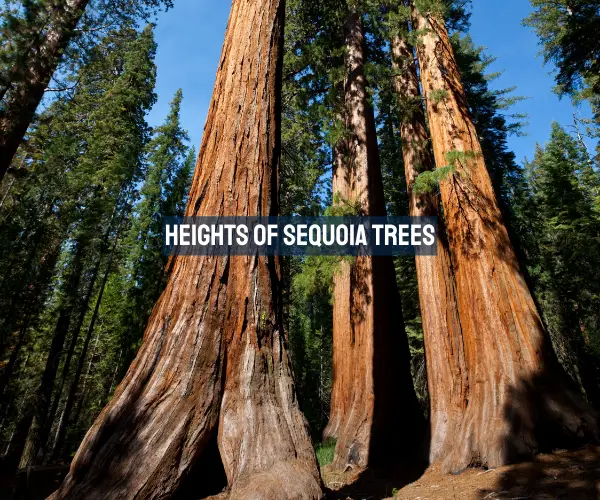Deep in the western Sierra Nevada mountains of California, some of the largest and oldest trees on the planet have been growing for millennia.
The giant sequoia trees also known as Sequoiadendron giganteum are truly breathtaking in their massive scale and incredible longevity.
While they aren’t the tallest trees in the world, many giant sequoias rank among the highest trees, reaching dizzying heights that boggle the mind and make humans feel incredibly small in comparison.

Heights of Sequoia Trees
The Contenders for the World’s Tallest
When it comes to the extremely tall trees, the giant sequoias go head-to-head with the coast redwoods (Sequoia sempervirens) which grow nearer to the Pacific coast in the western United States. The current record holder for tallest tree in the world is a coast redwood named Hyperion that towers 115.7 meters (379.7 feet) high in a remote part of Redwood National Park. However, giant sequoias regularly give the redwoods a run for their money.
The absolute highest known giant sequoia currently stands at around 83.8 meters (275 feet) tall. That’s higher than a 25-story building! This particular behemoth is located in the Mountain Home Grove of Giant Forest in Sequoia National Park. While not quite as tall as Hyperion, it’s an absolutely mind-blowing height for a single tree to reach up into the sky. Just imagine having to crane your neck straight back to try and see the top of this arboreal titan.
Many More Sequoia Skyscrapers
The incredible height of the tallest known giant sequoia is far from a fluke occurrence. These trees routinely grow to staggering heights, with many others reaching head-spinning altitudes as well. In fact, dozens of sequoias exceed 80 meters (262 feet) in height throughout the groves where they grow clustered together.
Sequoia National Park and the adjacent Kings Canyon National Park contain the largest remaining groves of giant sequoia trees. Between these two parks, there are at least 25 of these towering trees that soar over 80 meters high. The trunk diameters of some of these giants reach an astonishing 8 meters (26 feet) across at the base. Simply wrap your mind around that scale – you could easily fit a two-lane road through the hollow center of some of these gargantuan trees!
Just trying to look up at the tops of these 80+ meter tall sequoias is a daunting task that gives you an incredible crick in your neck. Their colossal trunks look like enormous russet columns holding up tons and tons of branches, bark, and foliage high overhead, reaching for the sun. If you’ve ever driven through a forest of giant sequoia trees, they appear as countless spires and steeples ascending all around you.
Walking among these giants, it’s easy to feel overawed, humbled, and oh so very small in comparison to their monumental and ancient scale. You truly feel like a tiny speck looking up in awe at nature’s biggest living wonders.
How Do They Get So Tall?
The ability of giant sequoia trees to attain such staggering heights is due to a combination of genetic characteristics, growing conditions, and life longevity. Sequoias belong to the redwood family of trees (Taxodiaceae) which are cone-bearing trees capable of reaching prodigious sizes.
What allows sequoias to get so tall? Some key factors include:
- Incredible longevity of over 3,000 years for some trees, giving them vast amounts of time to continue growing taller
- A tapering trunk ideal for dealing with the high stresses of height by being wider at the base
- An advanced hydraulic system and strong wood for transporting water/nutrients up the trunk
- Resistance to disease, rot, insects, and wildfire given their thick, spongy bark
- Growing conditions in groves that are ideal for maximizing height growth, with fertile soil, steady moisture, and protection from harsh winds
When you have trees able to reach ages of 2,000-3,000 years under the perfect growing circumstances found in their groves, it’s no surprise that some of them eventually get to be taller than a 20-30-story skyscraper! The oldest known giant sequoia is somewhere around 3,200 years old, predating ancient Greece and the Roman Empire. Just imagine the events in human history that trees have lived through while continually adding inch after inch of height over the millennia.
Challenges of Measuring Tall Trees
So how exactly do researchers and scientists measure the heights of these towering giant sequoia trees anyway? It’s obviously no easy feat to get an accurate height reading on a 275-foot-tall tree! In the past, some fairly crude and risky methods were used such as climbing the tree with a tape measure or using trigonometry with weighted lines and protractors from the ground.
Modern techniques used today rely heavily on laser rangefinders and clinometers combined with computer modeling to get precise readings on the height and other dimensions of the trees. Paths are bushwhacked through the sequoia groves and




